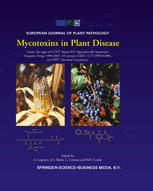

Most ebook files are in PDF format, so you can easily read them using various software such as Foxit Reader or directly on the Google Chrome browser.
Some ebook files are released by publishers in other formats such as .awz, .mobi, .epub, .fb2, etc. You may need to install specific software to read these formats on mobile/PC, such as Calibre.
Please read the tutorial at this link: https://ebookbell.com/faq
We offer FREE conversion to the popular formats you request; however, this may take some time. Therefore, right after payment, please email us, and we will try to provide the service as quickly as possible.
For some exceptional file formats or broken links (if any), please refrain from opening any disputes. Instead, email us first, and we will try to assist within a maximum of 6 hours.
EbookBell Team

4.7
56 reviewsThere is an urgent need to expand our knowledge of both the nature of the toxigenic fungi that are widespread on economically-important plants and the effect of their toxic secondary metabolites on human health. Informa tion about the production of mycotoxins by plant pathogens, particularly by species of Fusarium, Aspergillus and Penicillium, their occurrence in infected plants, as well as their role in the plant-pathogen interaction, for example as virulence/pathogenicity factors, is a pre-requisite for preventing plant disease and hence for reducing the Ievels of mycotoxin contamination. Fusarium infections in cereals and other crops are a particular problern world-wide and recent epidemics on wheat in Europe, the USA and Canada have again focused attention on this problem. Fur thermore, species ofAspergillus and Penicillium and their related mycotoxins, particularly Ochratoxin A, represent another consistent problern on cereals and grapes, especially in Europe where 40% of the global grape crop is grown. The aim of this publication is to gather together specialist updated reviews based on papers originally presented during a Workshop of EU Cost Action 835 entitled 'Agriculturally Important Taxigenie Fungi', held in Rome, 7-8 October 1999 at the Plant Pathology Research Institute. We hope the diversity of the contents will stimulate discussion, encourage the sharing of information and result in cross-fertilization of ideas needed for the solution of the present problems. This special issue will be of particular value to interdisciplinary scientists and especially mycologists, mycotoxicologists, plant pathologists and those concerned about the quality of food and food products.